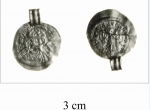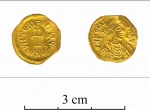Tremissis
Tremissis, plural tremisses (FIG. 1-2.) – gold coin introduced as part of the monetary reform in Late Antiquity, see →Solidus, →Follis . In numismatics also referred to as triens. In 313 the tremissis amounted to 3/8 solidus and weighed 1.71 g, starting from 383 (or 384) it was the third part of a solidus and weighed 1.51 g. On its obverse was the image of the imperial bust facing, on its reverse, Victory advancing holding a wreath and a globe surmounted by a cross. After 578 the reverse image is that of the cross.
The tremissis went on to play a significant role during the →Migration Period , especially in the early coinage activity of the →Germanic Tribes . Imitating coinage by barbarians was generally prohibited, and imitating gold coins in particular aroused a strong opposition of Constantinople. The first – around 539 – to issue gold solidi and tremisses in his own name was Theudebert, the king of Austrasia (534-548). In describing this event →Procopius of Caesarea does not hide his indignation, stressing that that not even had dared to trespass on the Roman prerogative to mint gold coins (De bello gothico III.33., pp. 438-439).
When in 5th-7th centuries other →Germanic Tribes started minting their coinage the tremissis was one of the coins most frequently imitated by →Ostrogoths , →Visigoths , →Langobards, →Burgundians, Suebi, →Franks and Frisians.
In 6th-7th centuries the tremisses observably become lighter, in late 6th century they weigh 1.3 grams. This is especially true of the Merovingian Kingdom where the gold content of the tremissis was lowered on a regular basis. Around 670 the tremissis ceased to be minted and was replaced by the silver denarius. The →Langobards and →Visigoths continued issuing tremisses in the 8th c. and when their kingdoms foundered gold coinage disappeared from Western Europe; it would be minted on a regular basis again only in the wake of a great reform of coinage during the High Middle Ages (13th c.).
MW
Literature: W. Hahn, Moneta Imperii Byzantini, Wien 1973, 1975, 1981, vol. I-III; S. Suchodolski, Moneta i obrót pieniężny w Europie zachodniej, Wrocław-Warszawa-Kraków-Gdańsk-Łódź 1982; Ph. Grierson, M. Blackburn, Medieval European Coinage, vol. I, The Early Middle Ages (5th – 10th Centuries), Cambridge 1986; M. Salamon, Mennictwo bizantyńskie, Kraków 1987; J. P. C. Kent, Roman Imperial Coinage, t. X, The Divided Empire and the Fall of the Western Parts, London 1994; W. Hahn, M. A. Metlich, Money of the Byzantine Empire, Wien 2000; B. Kluge, Numismatik des Mittelalters. Handbuch und Thesaurus Nummorum Medii Aevi, Berlin-Wien 2007.
Written sources: Prokopiusz z Cezarei, Procopius IV, History of the Wars. Books VI. 16 – VII. 35, H. B. Dewing (ed.), LOEB 173, Cambridge-London 1924.
-
 full resolution
full resolution
Fig. 1. Lužice, okres Hodonín, Czech Republic; tremissis of Justinian I (527-565) Constantinople mint; according to J. Militký, Finds of the Early Byzantine Coins of the 6th and the 7th century in the territory of the Czech Republic, ( M. Wołoszyn (ed.) 20
-
 full resolution
full resolution
Fig. 2. Krsice, okres Písek, Czech Republic; tremissis of Phocas (602-610), Constantinople mint, 602-607; according to J. Militký, Finds of the Early Byzantine Coins of the 6th and the 7th century in the territory of the Czech Republic, (M. Wołoszyn (ed.)


